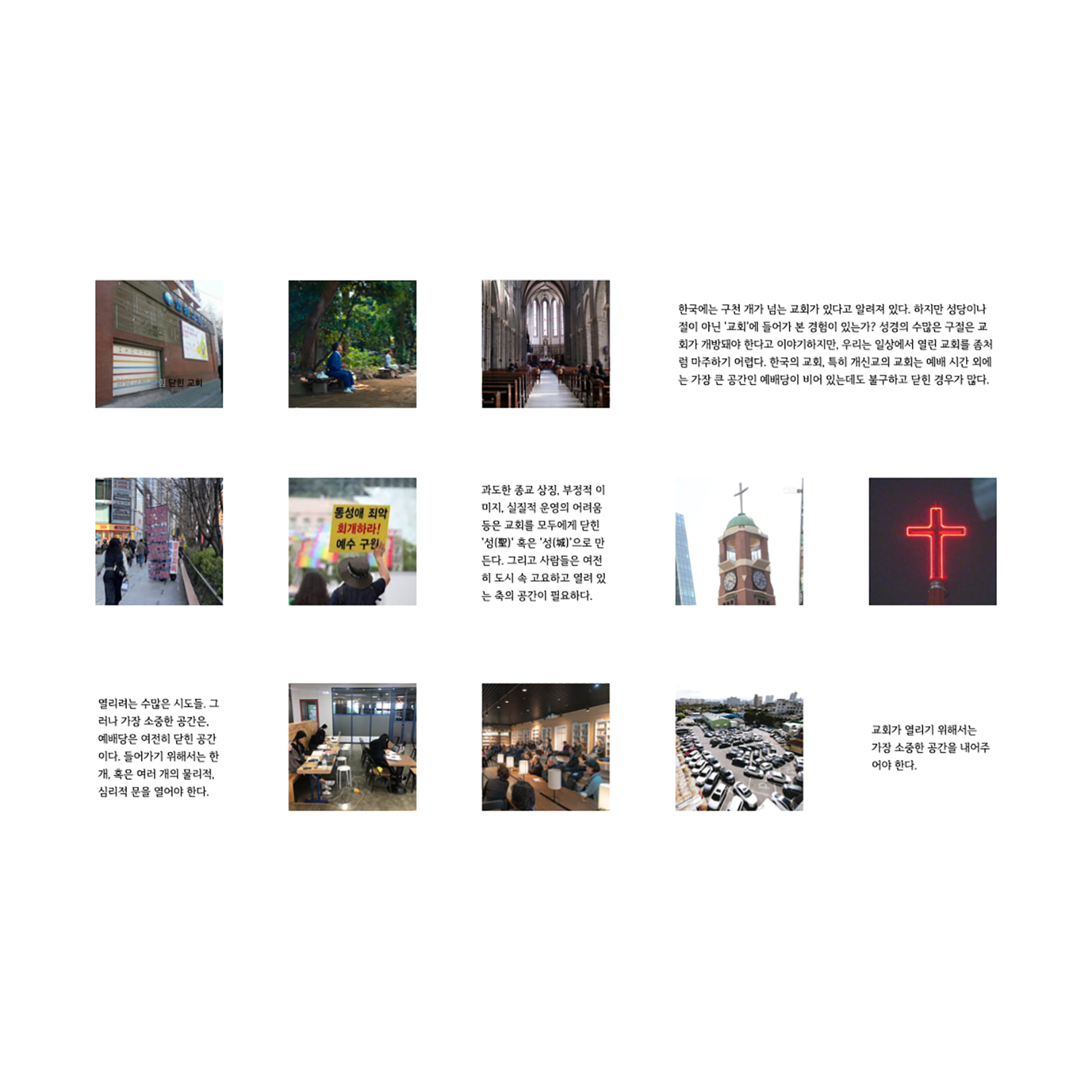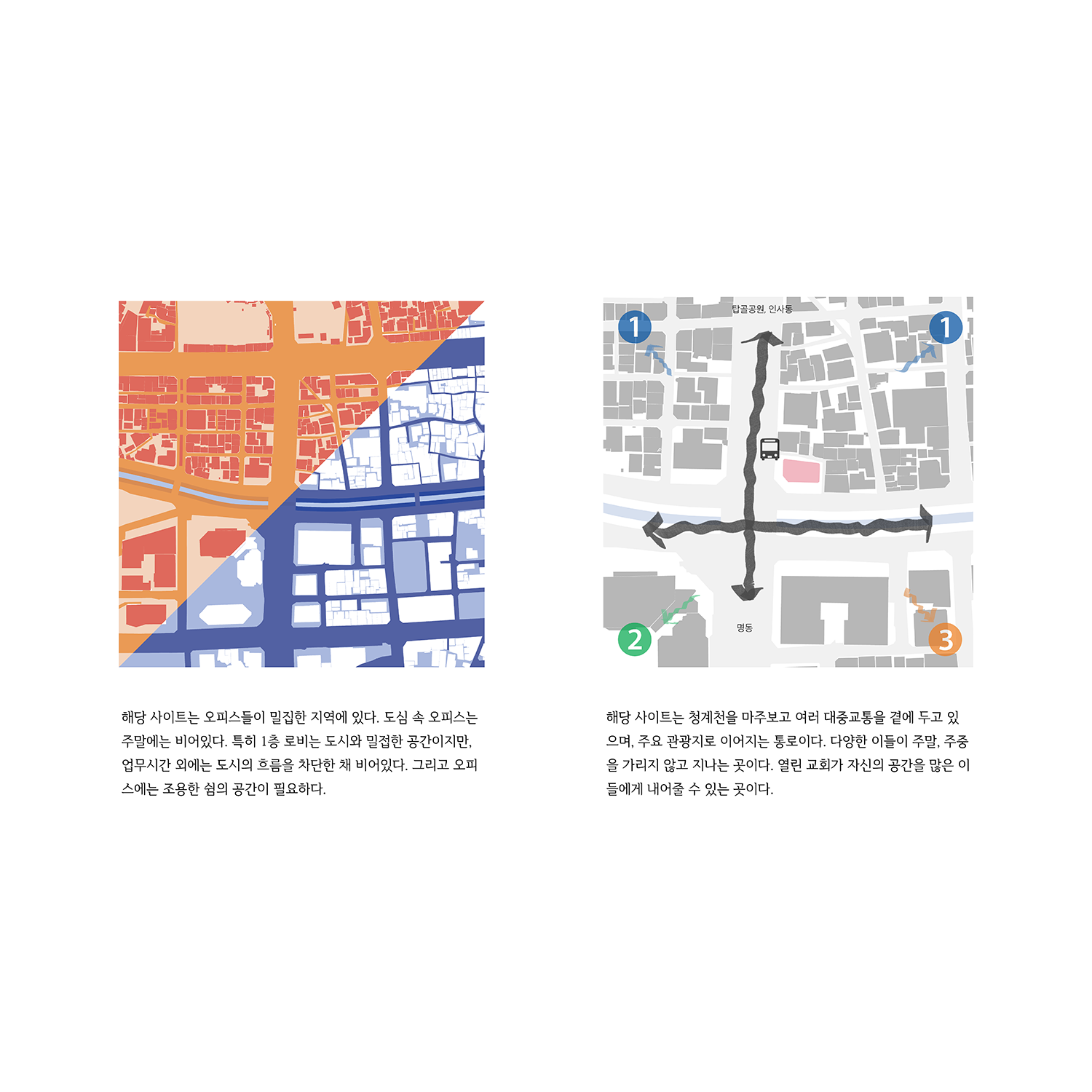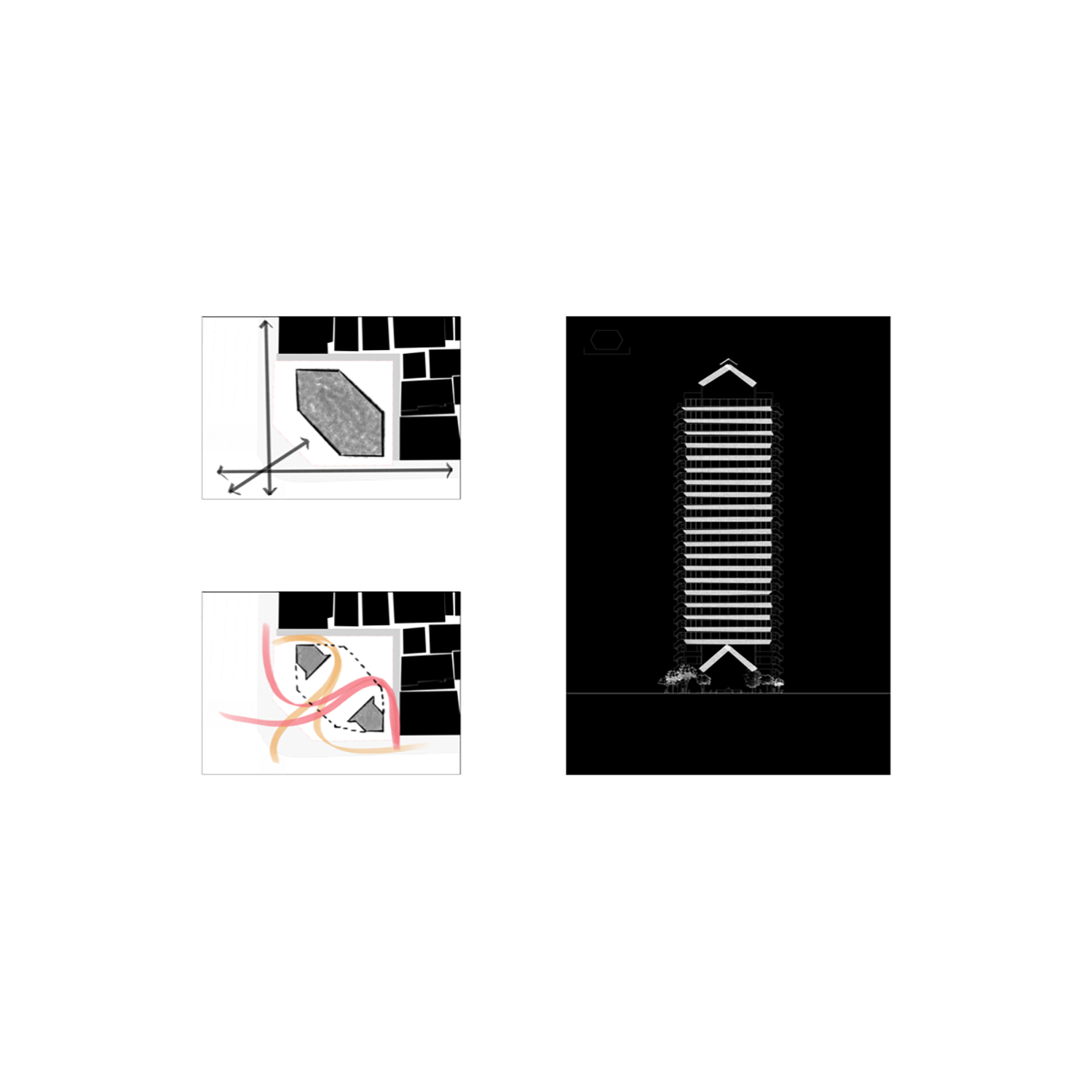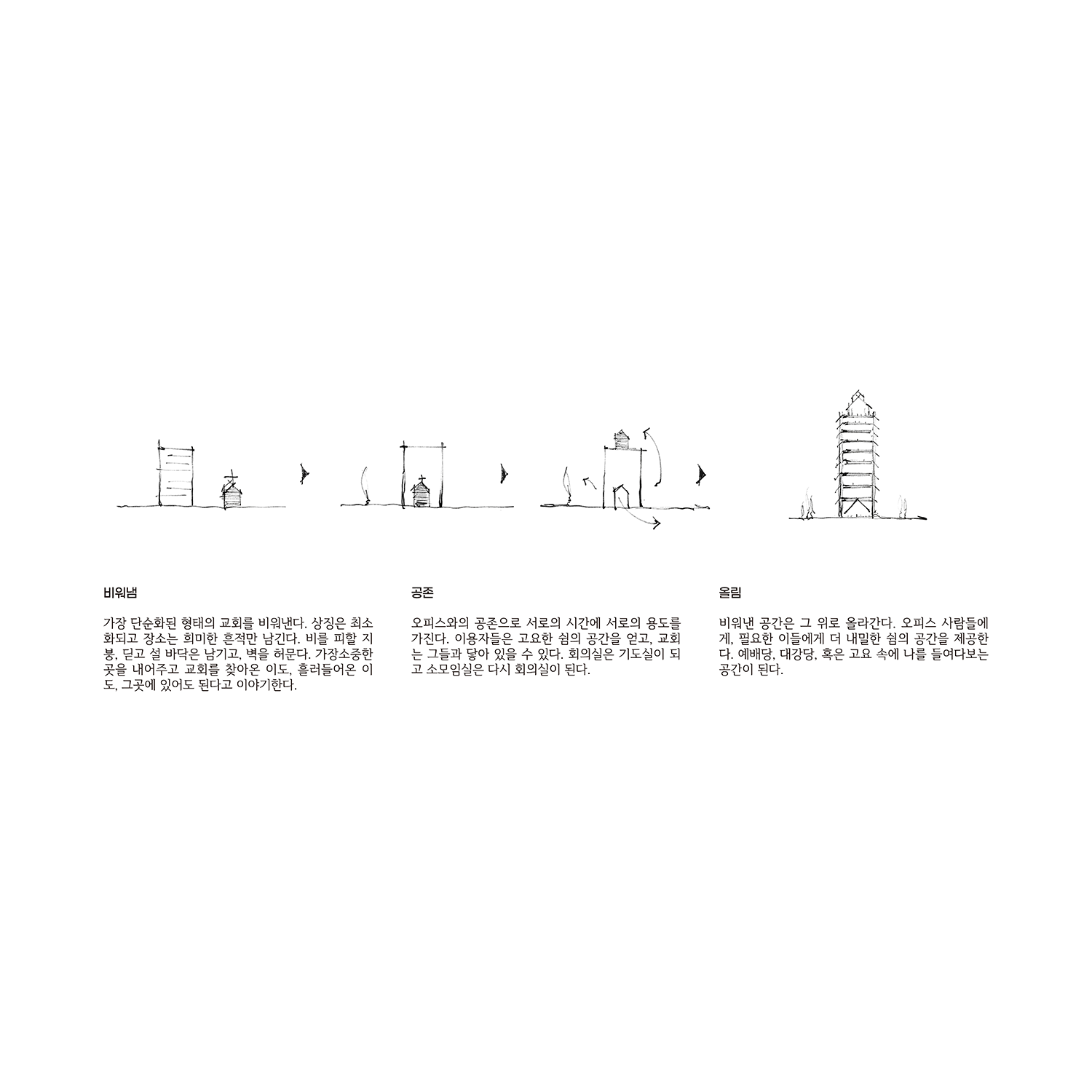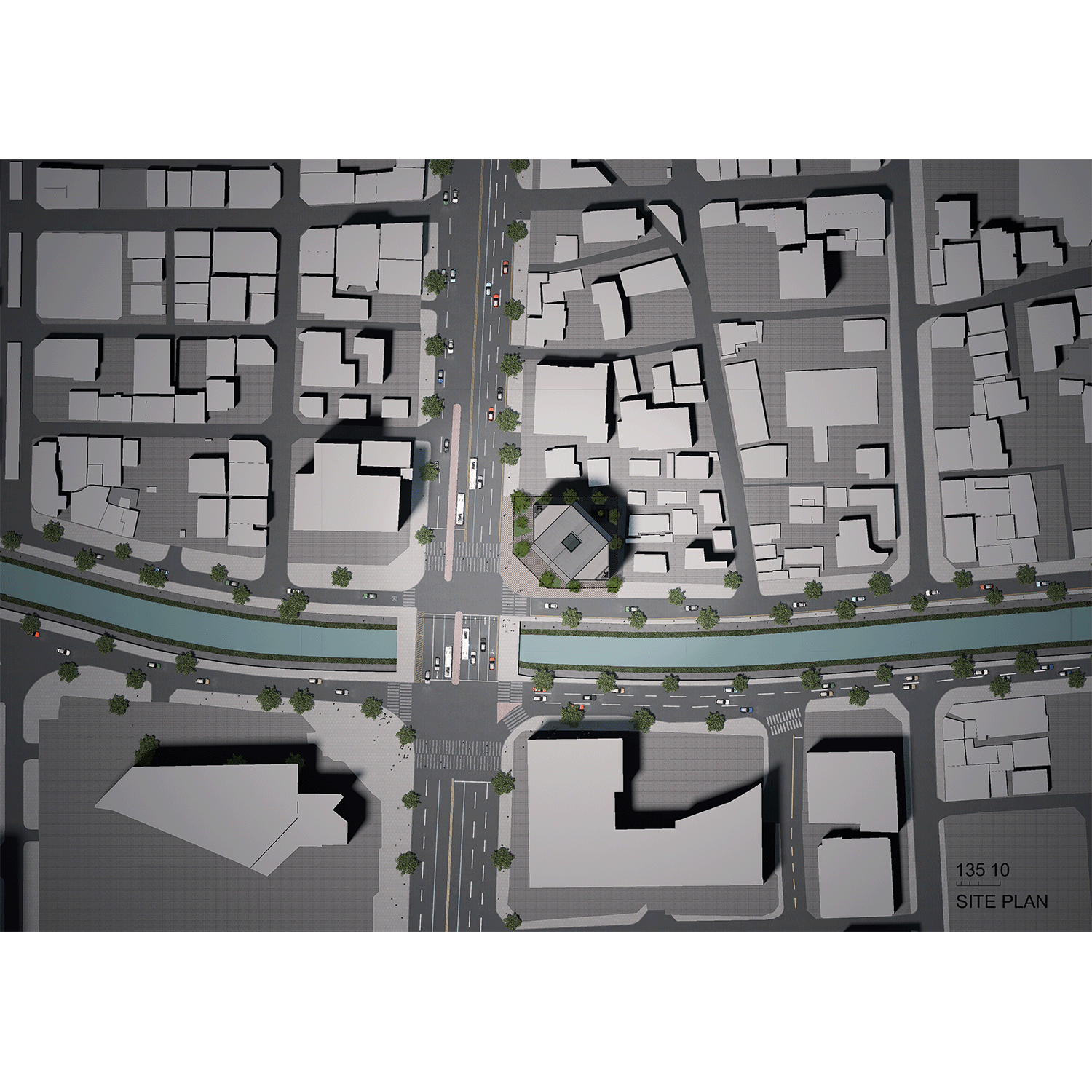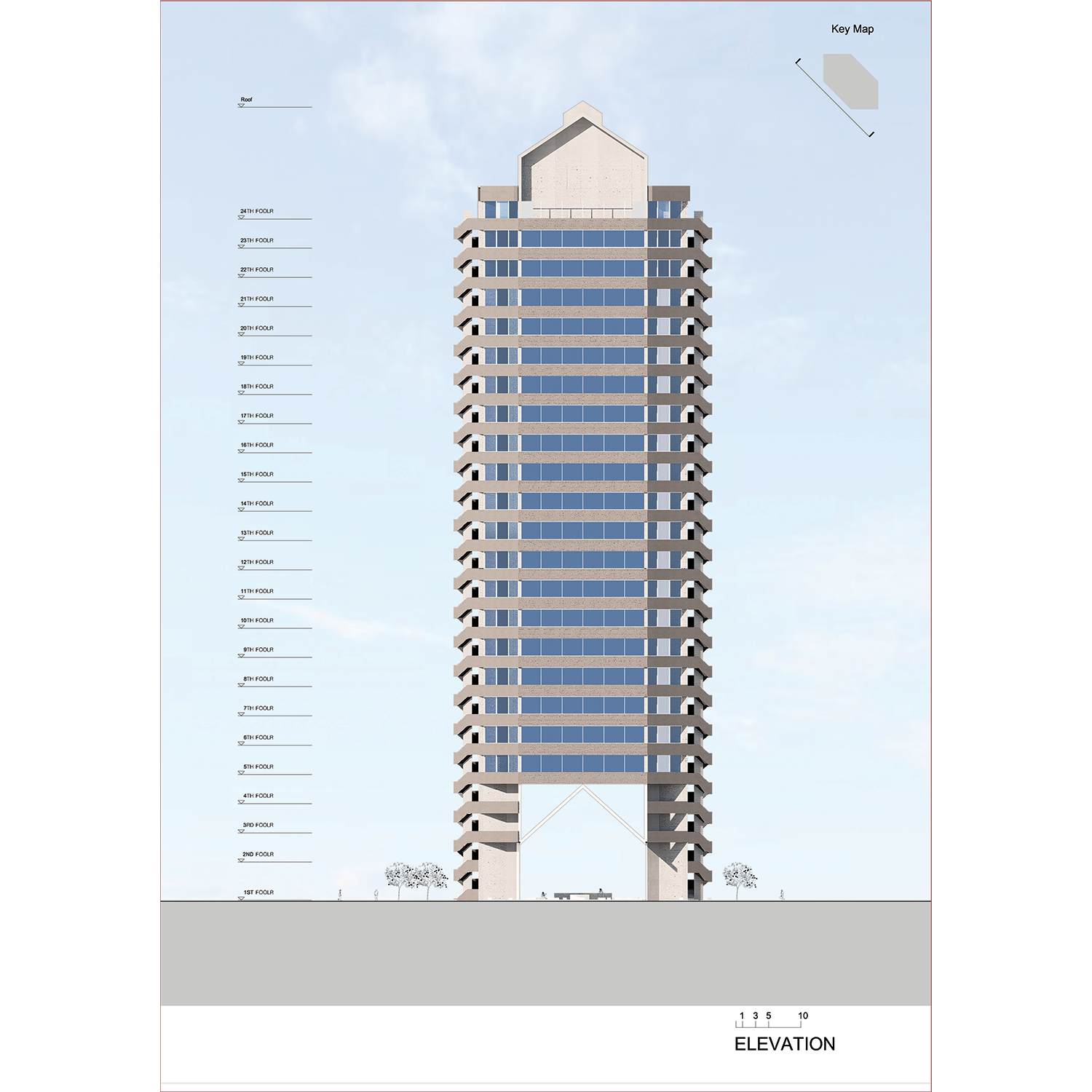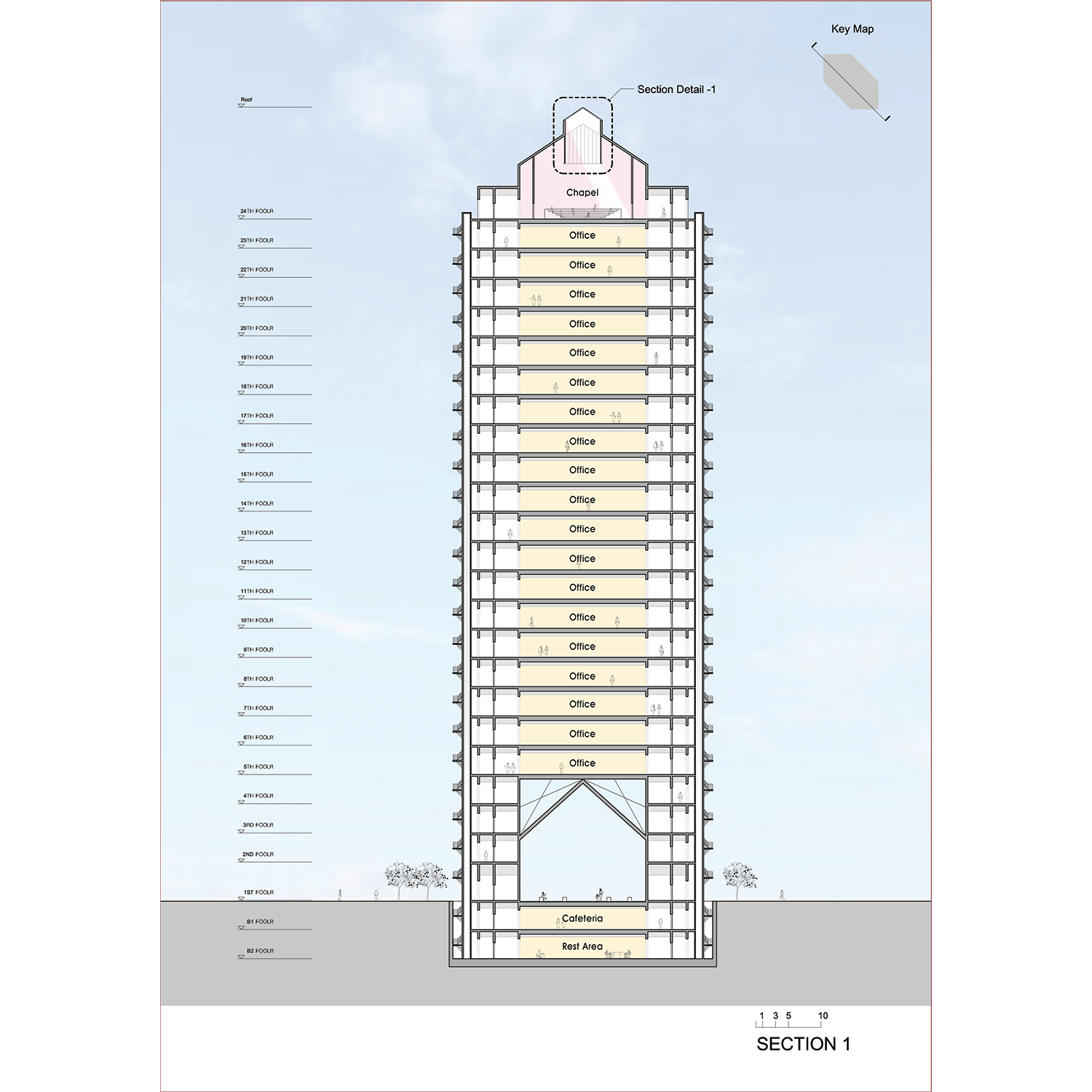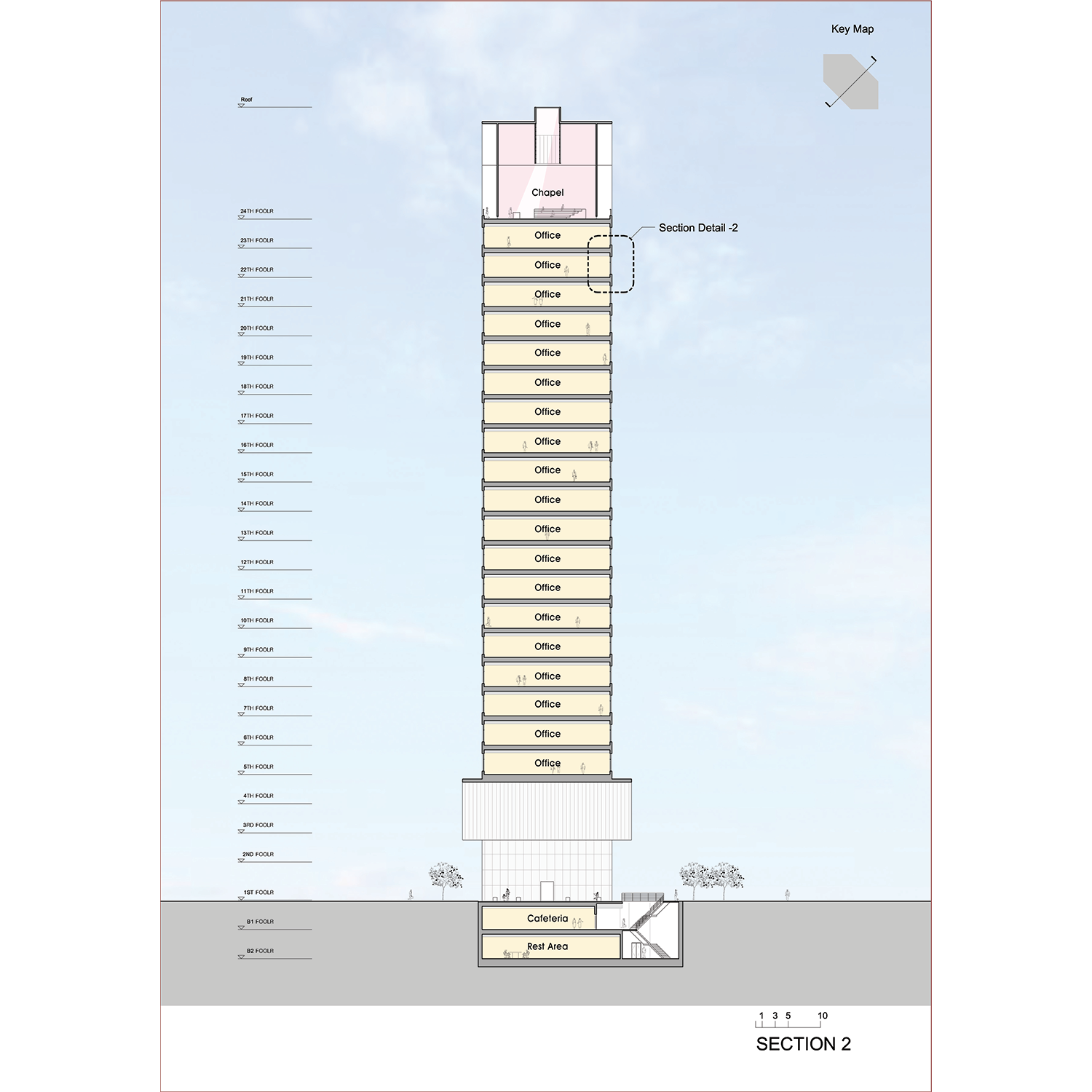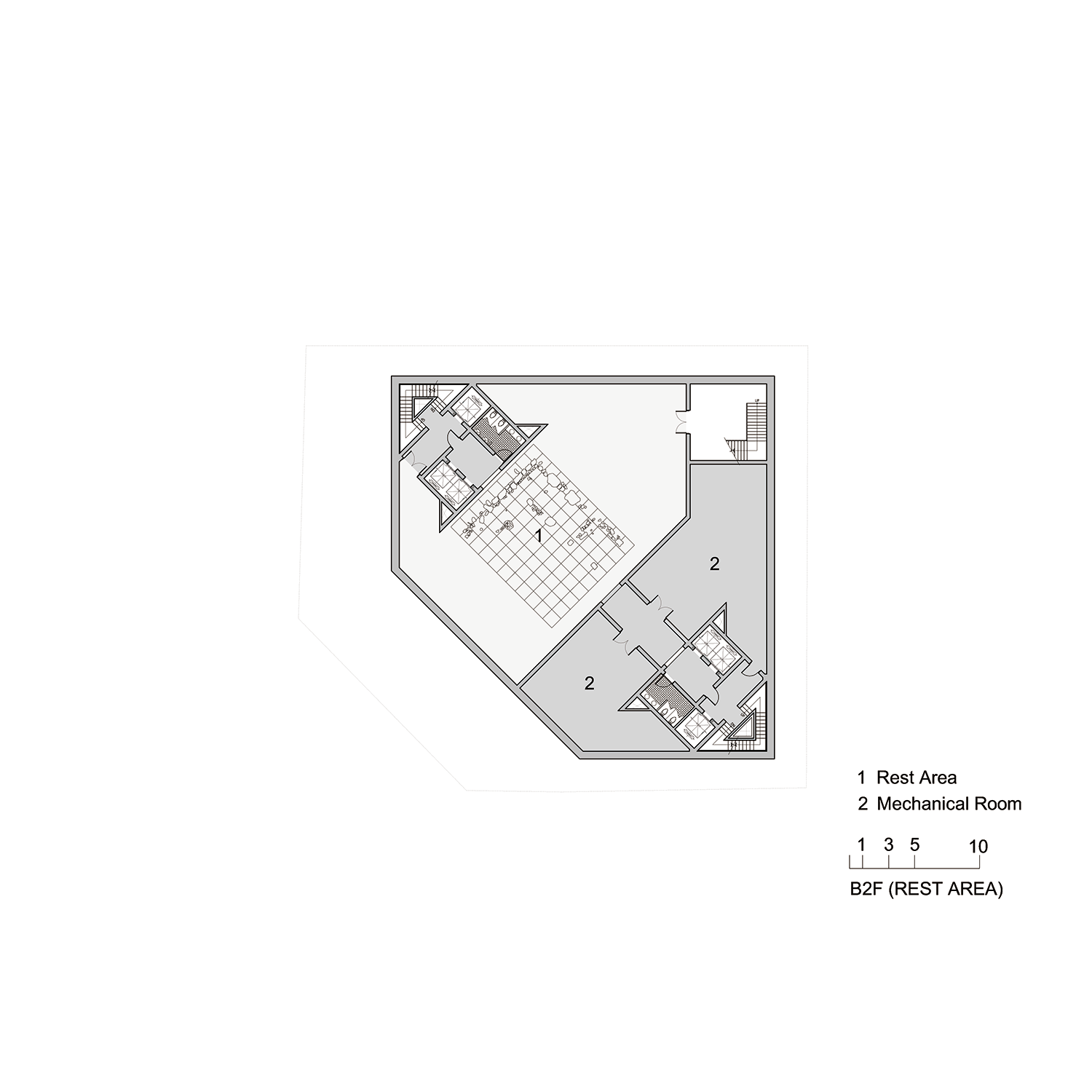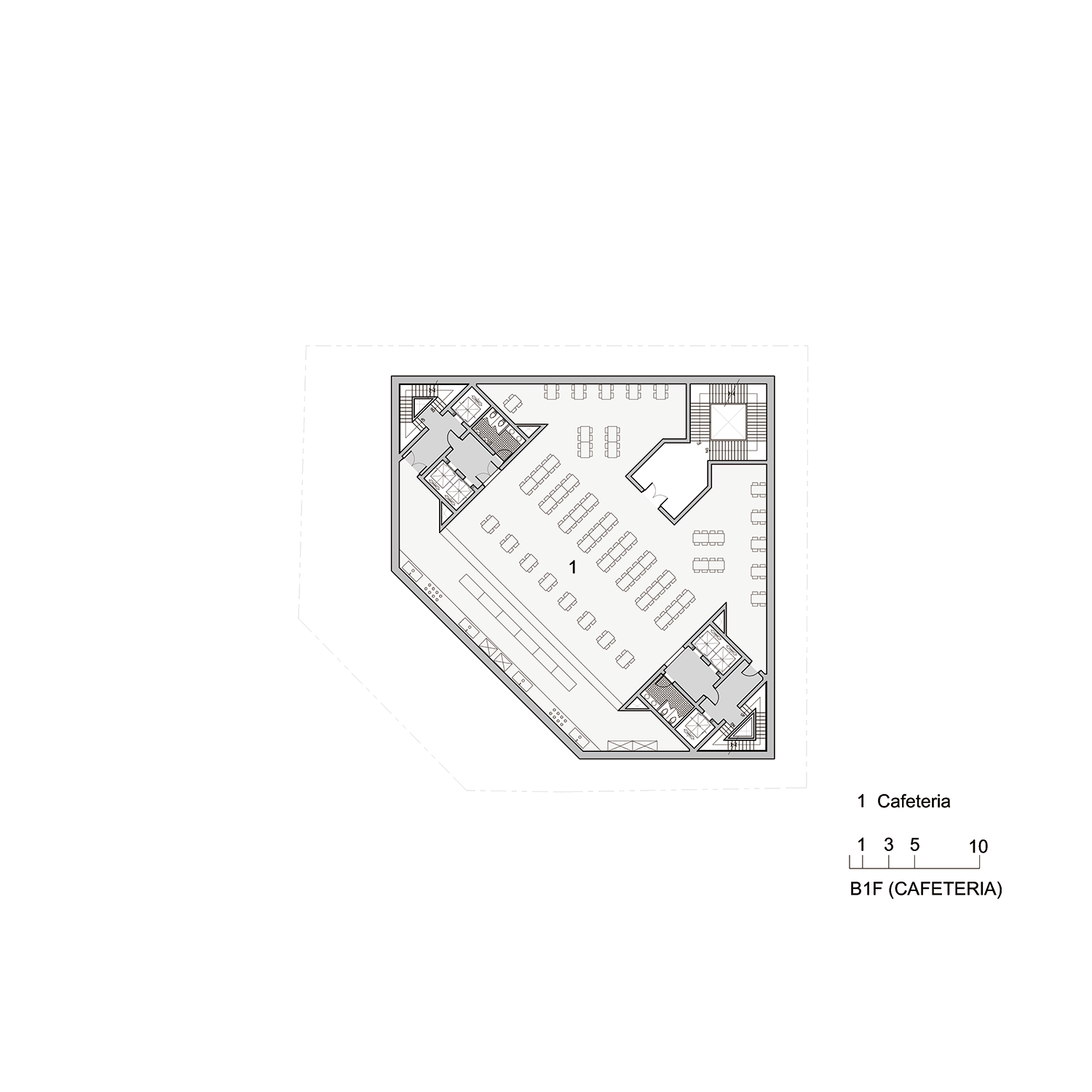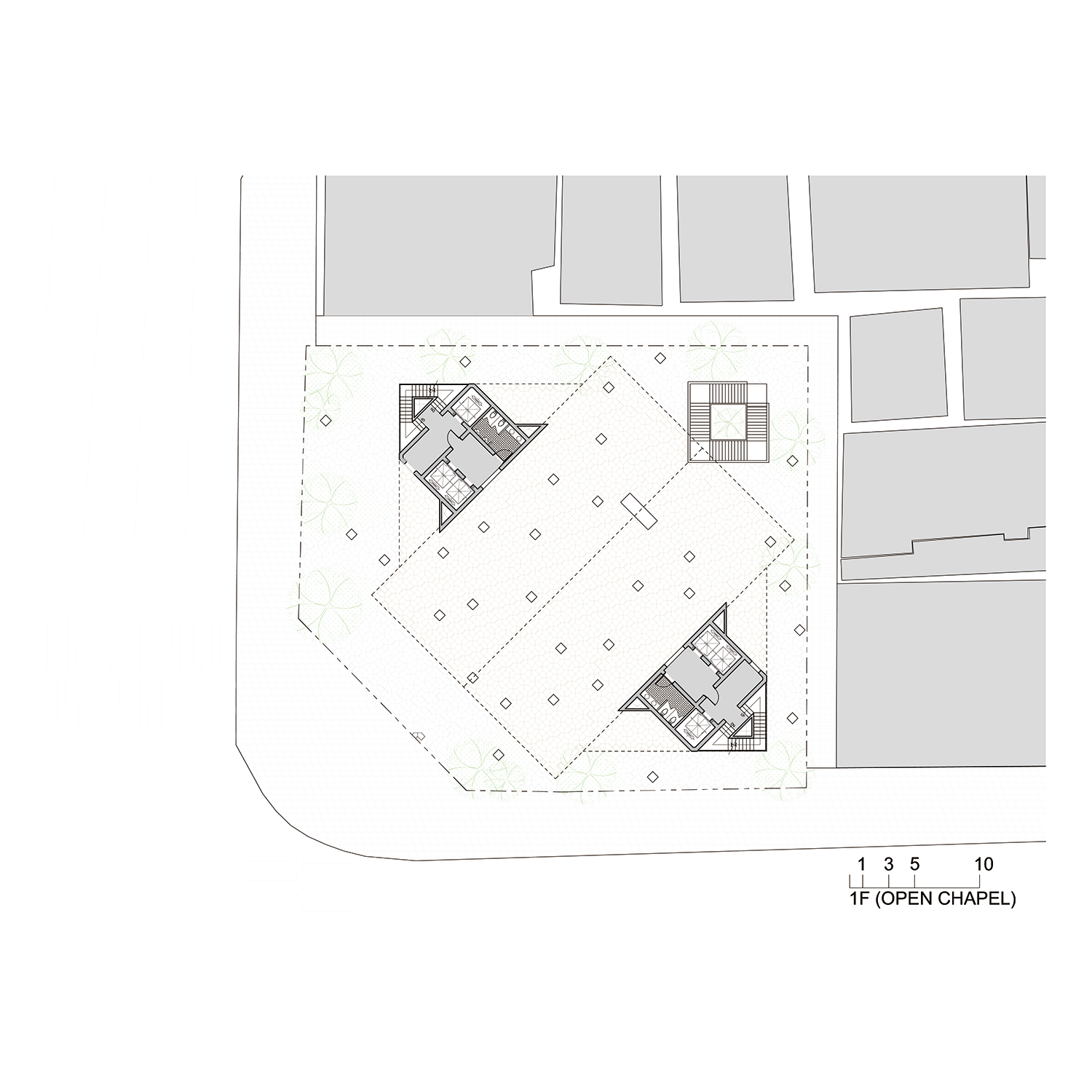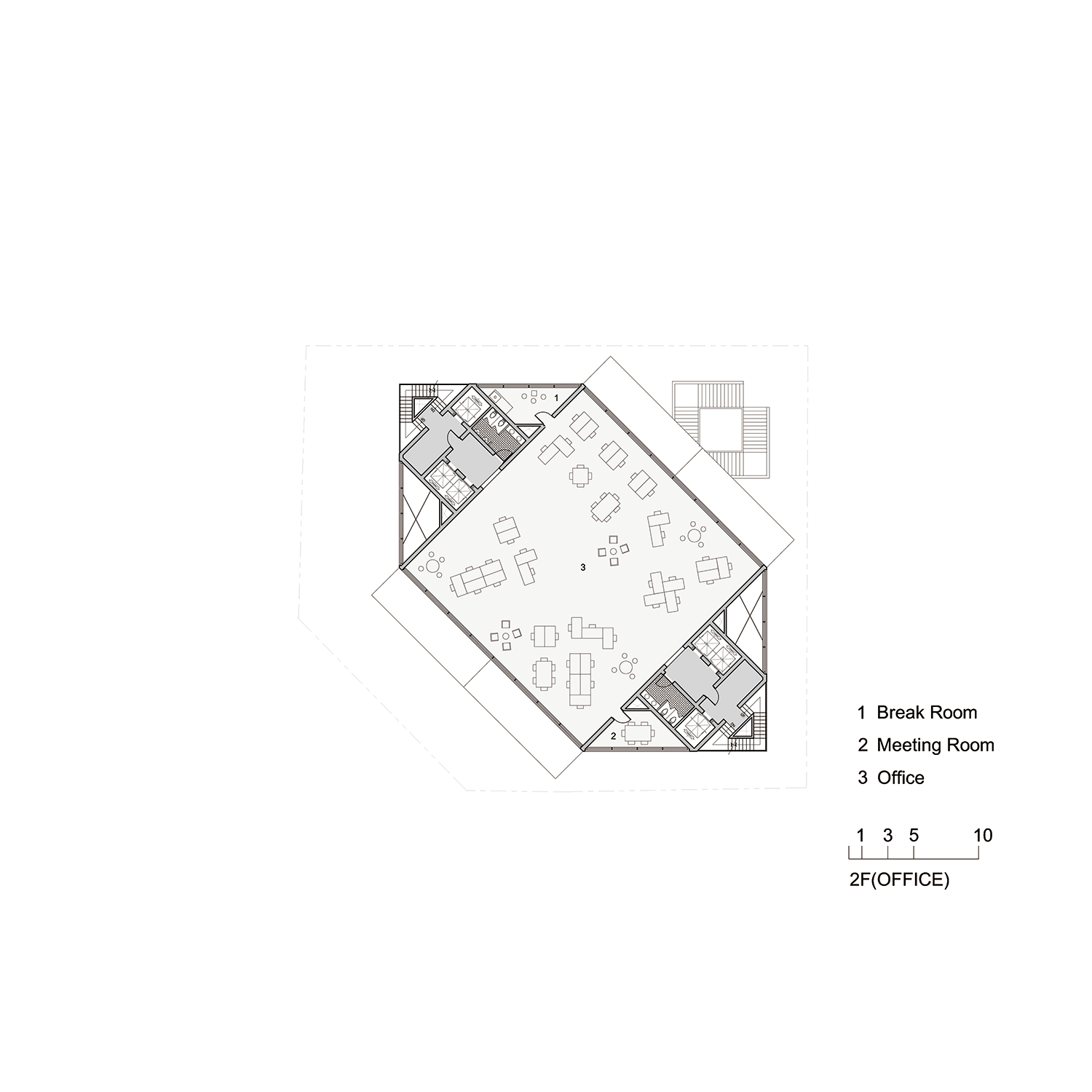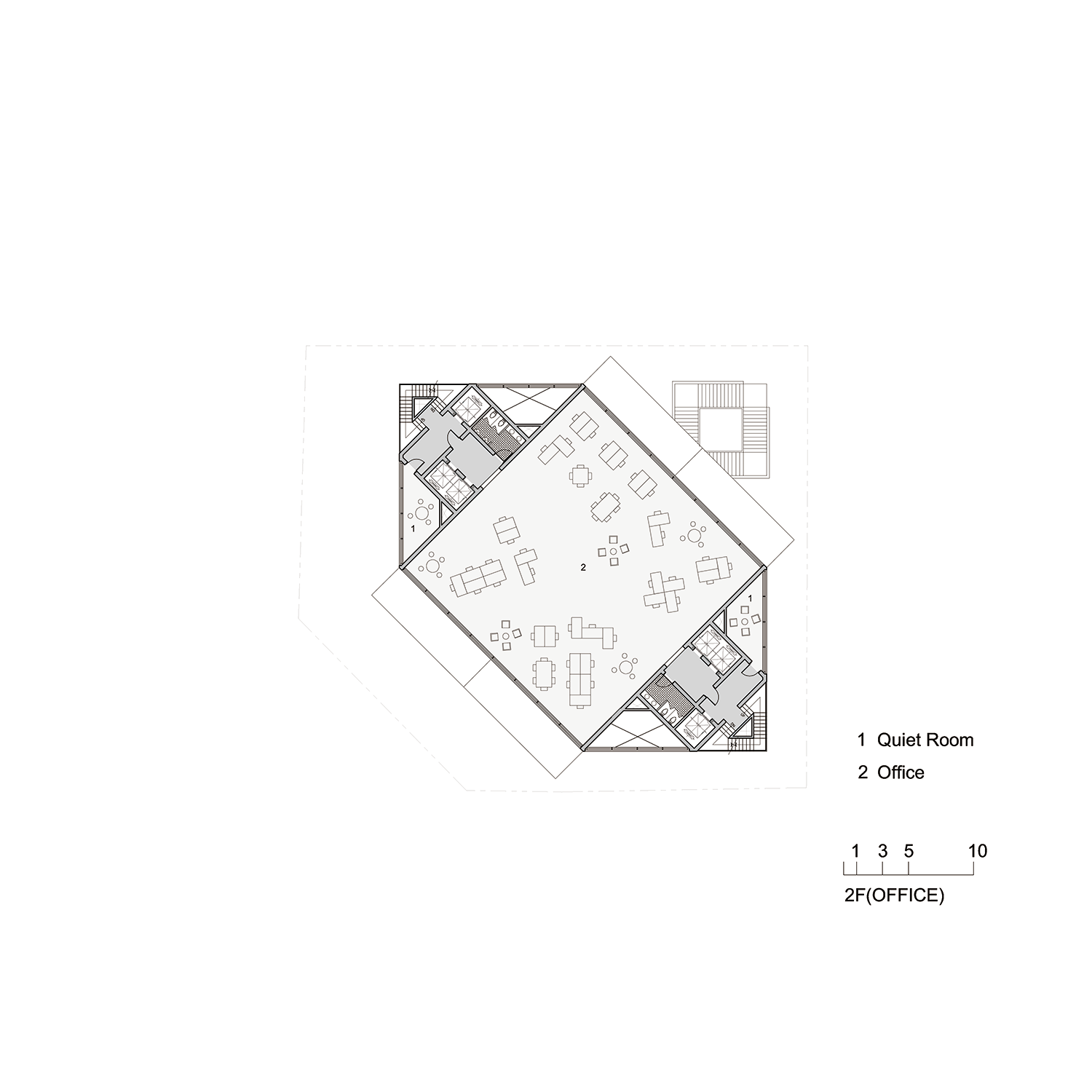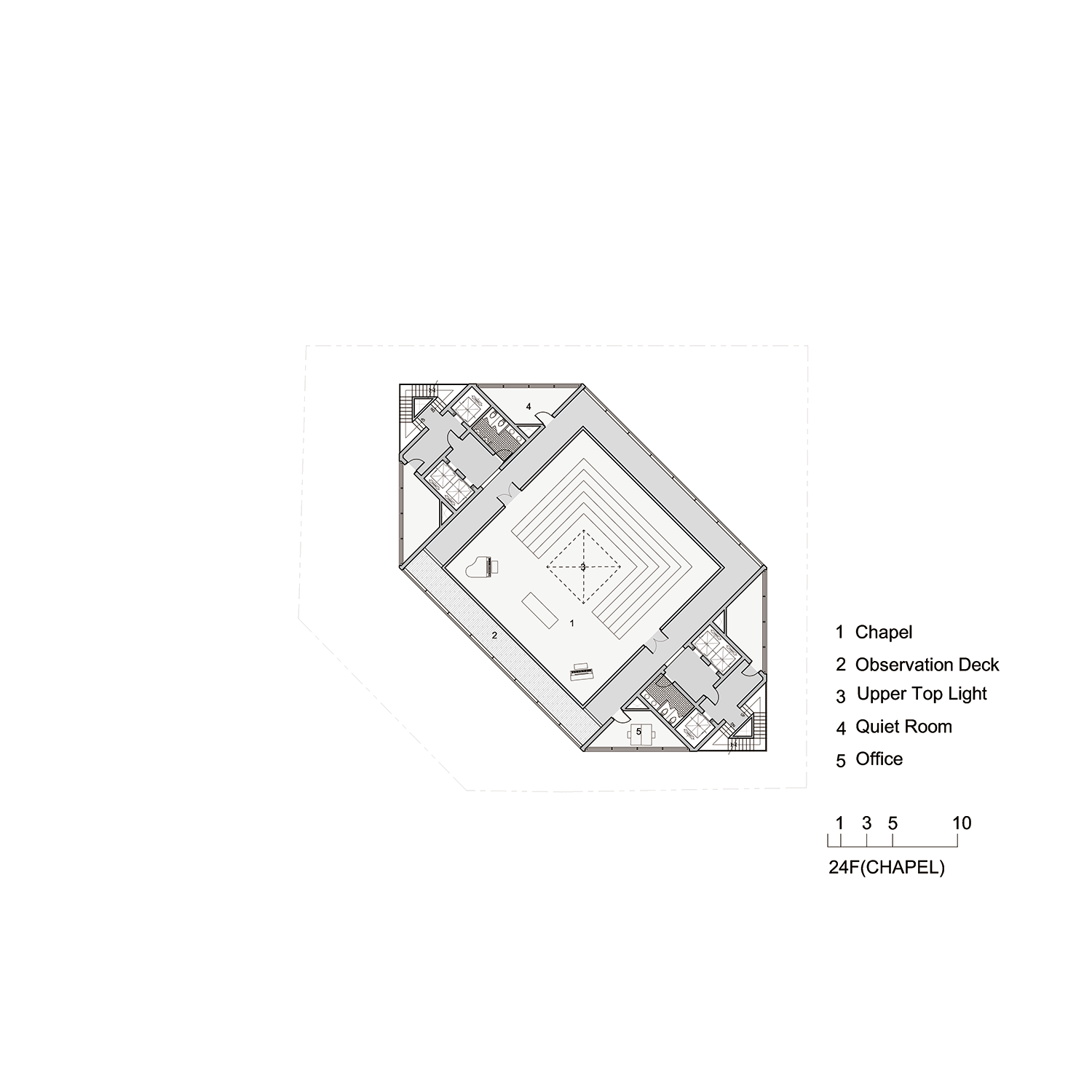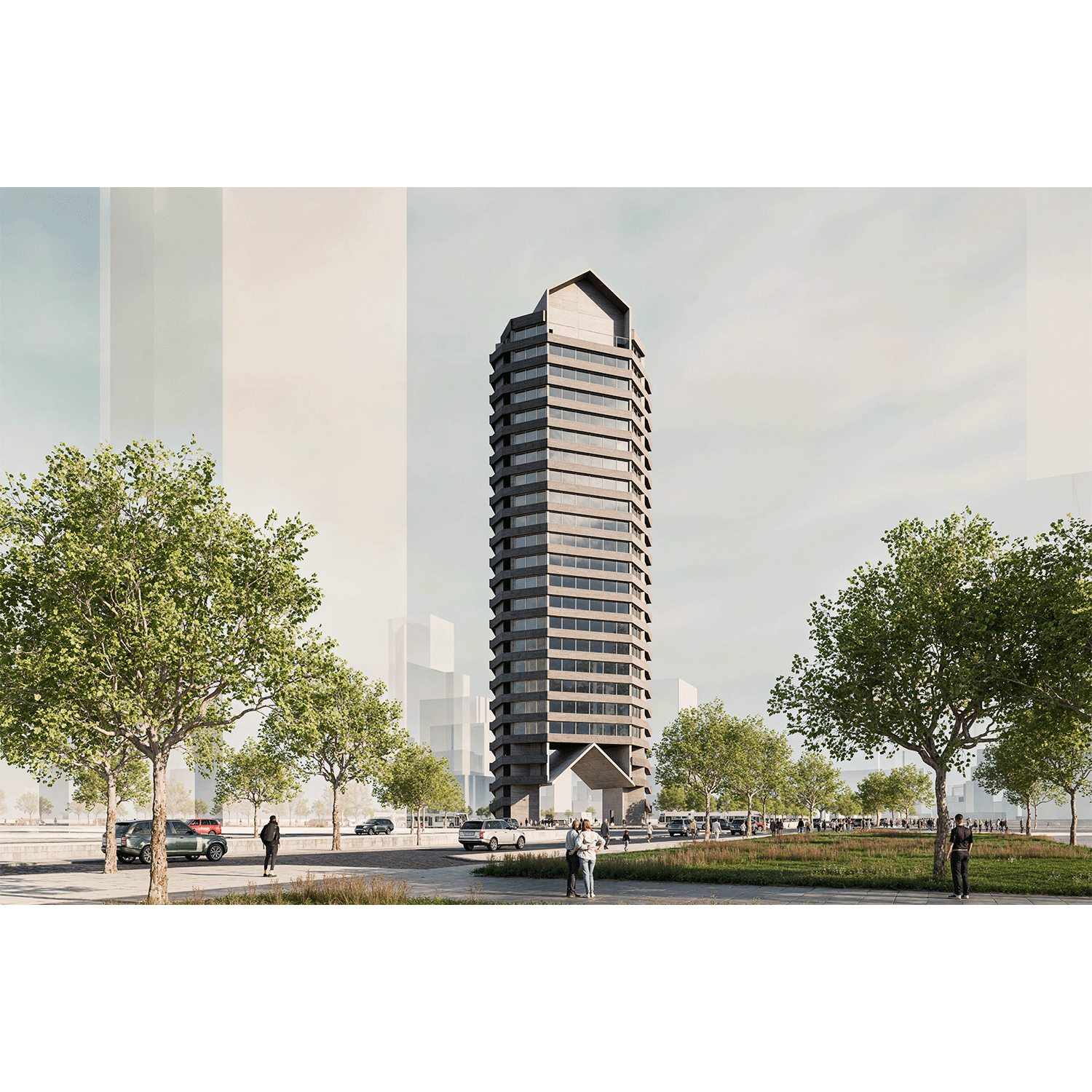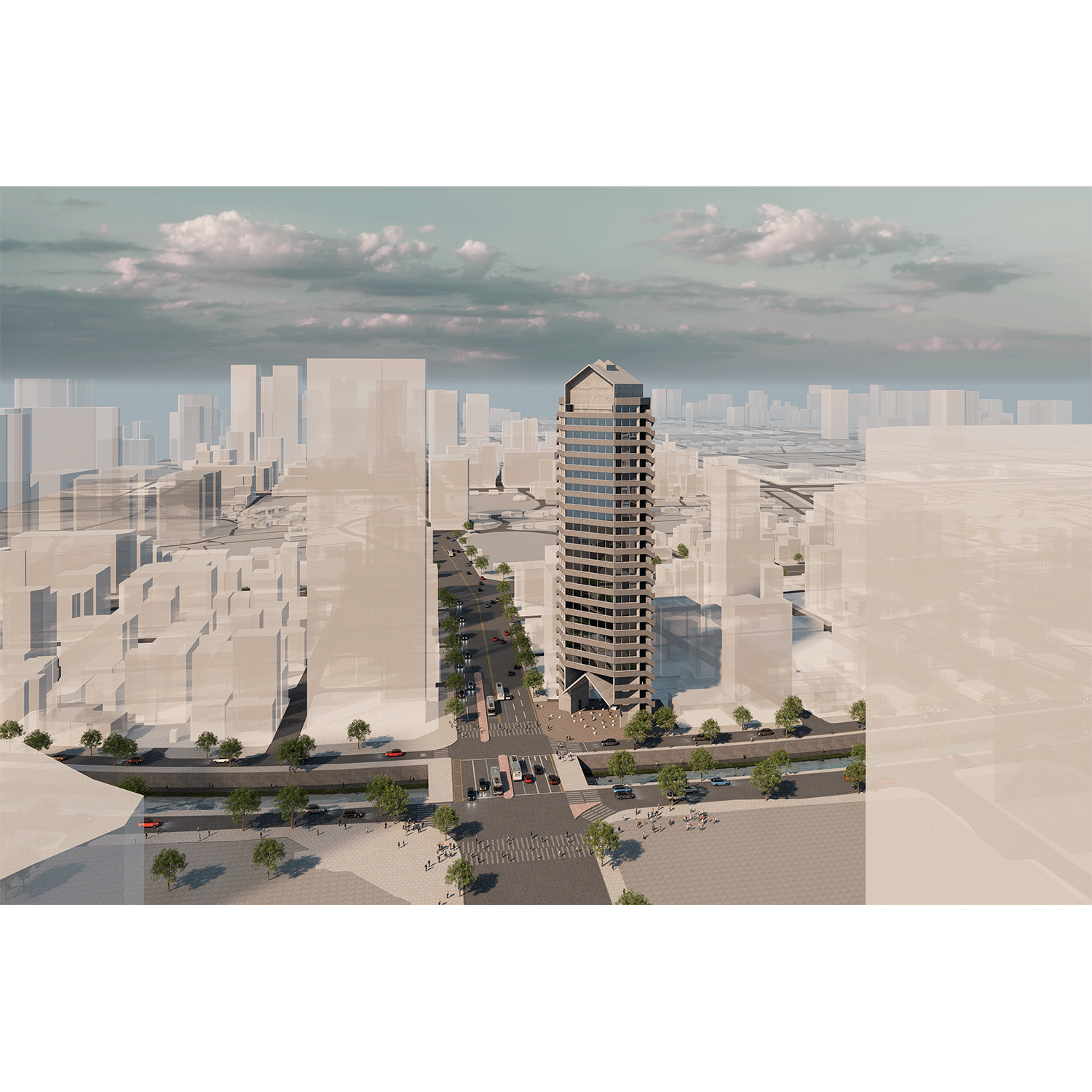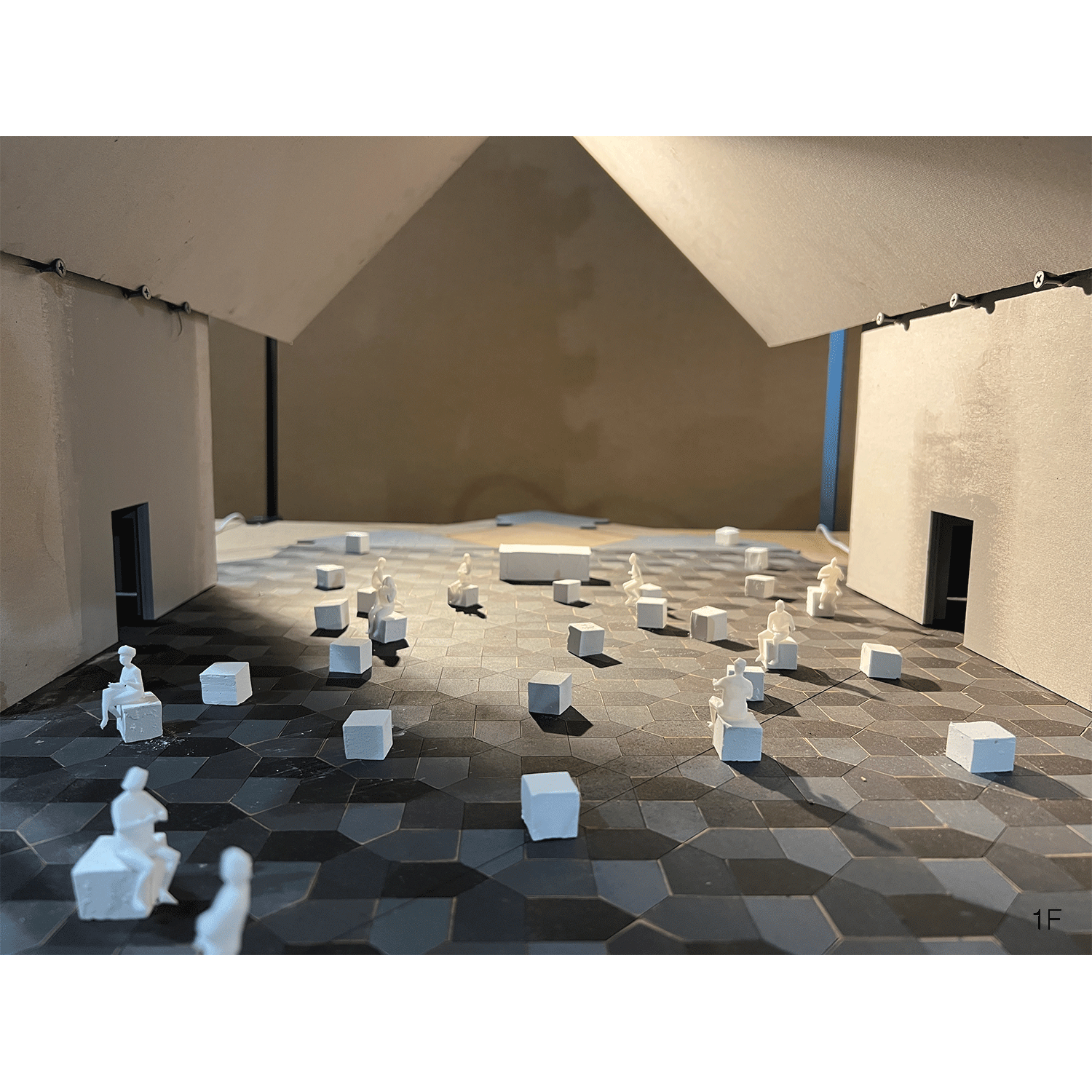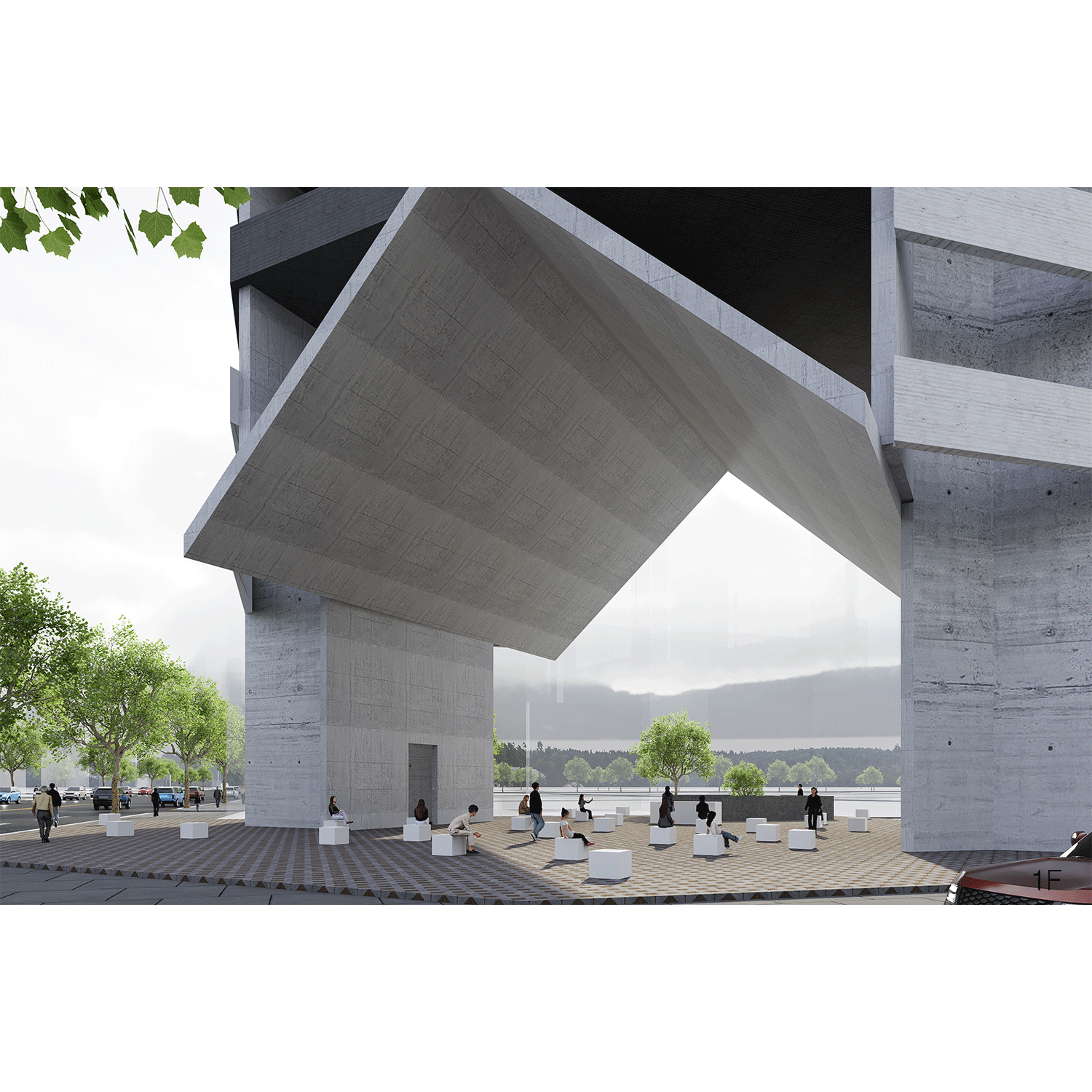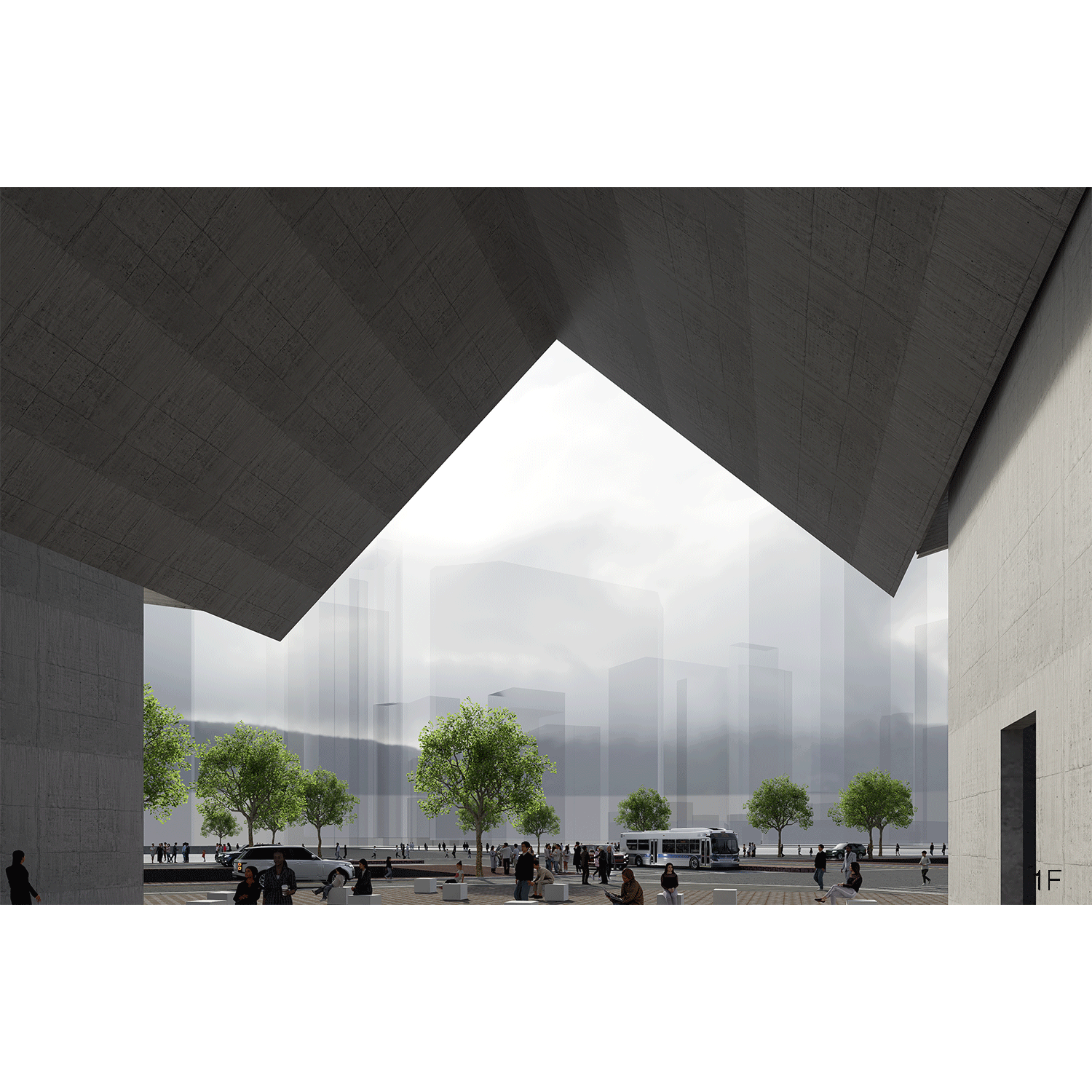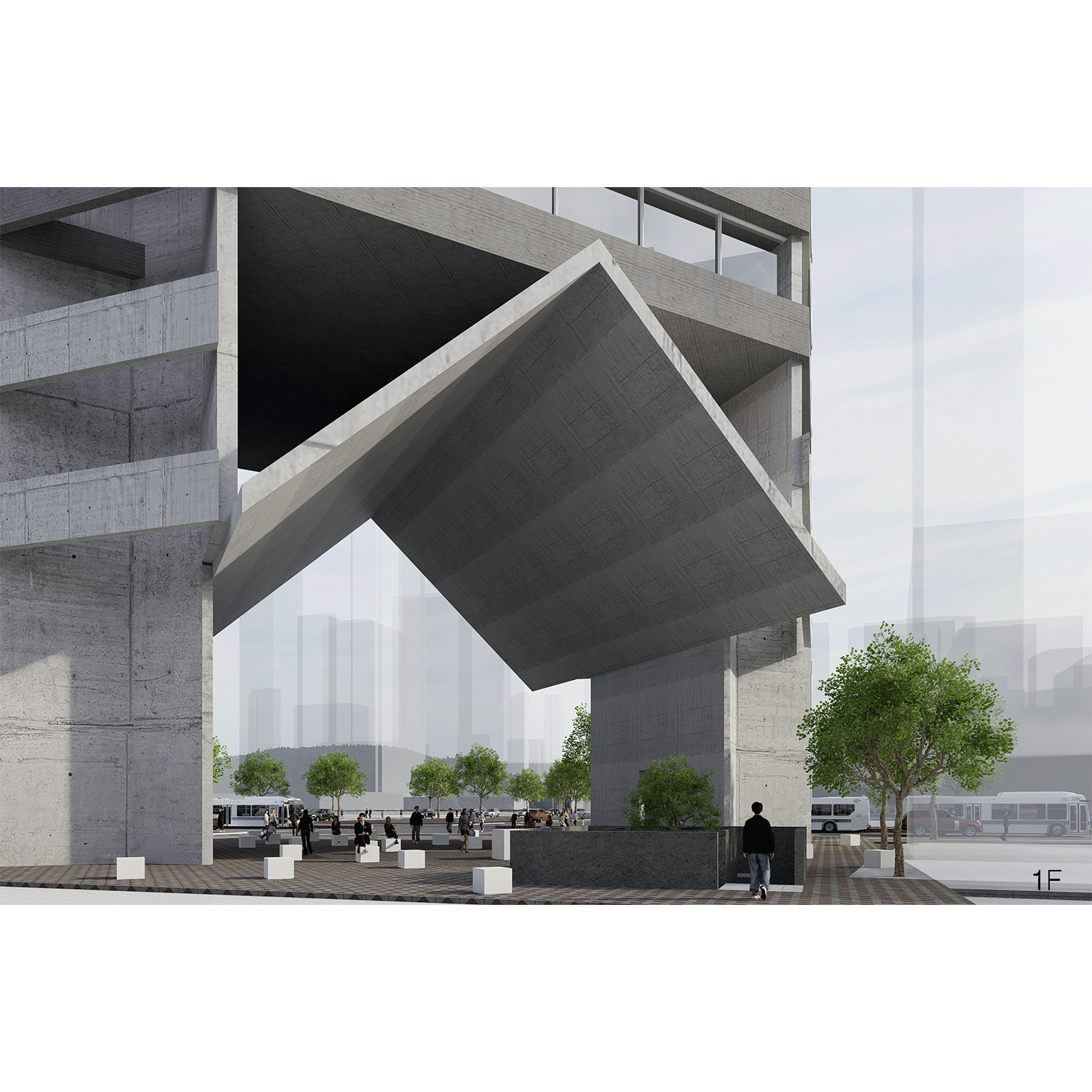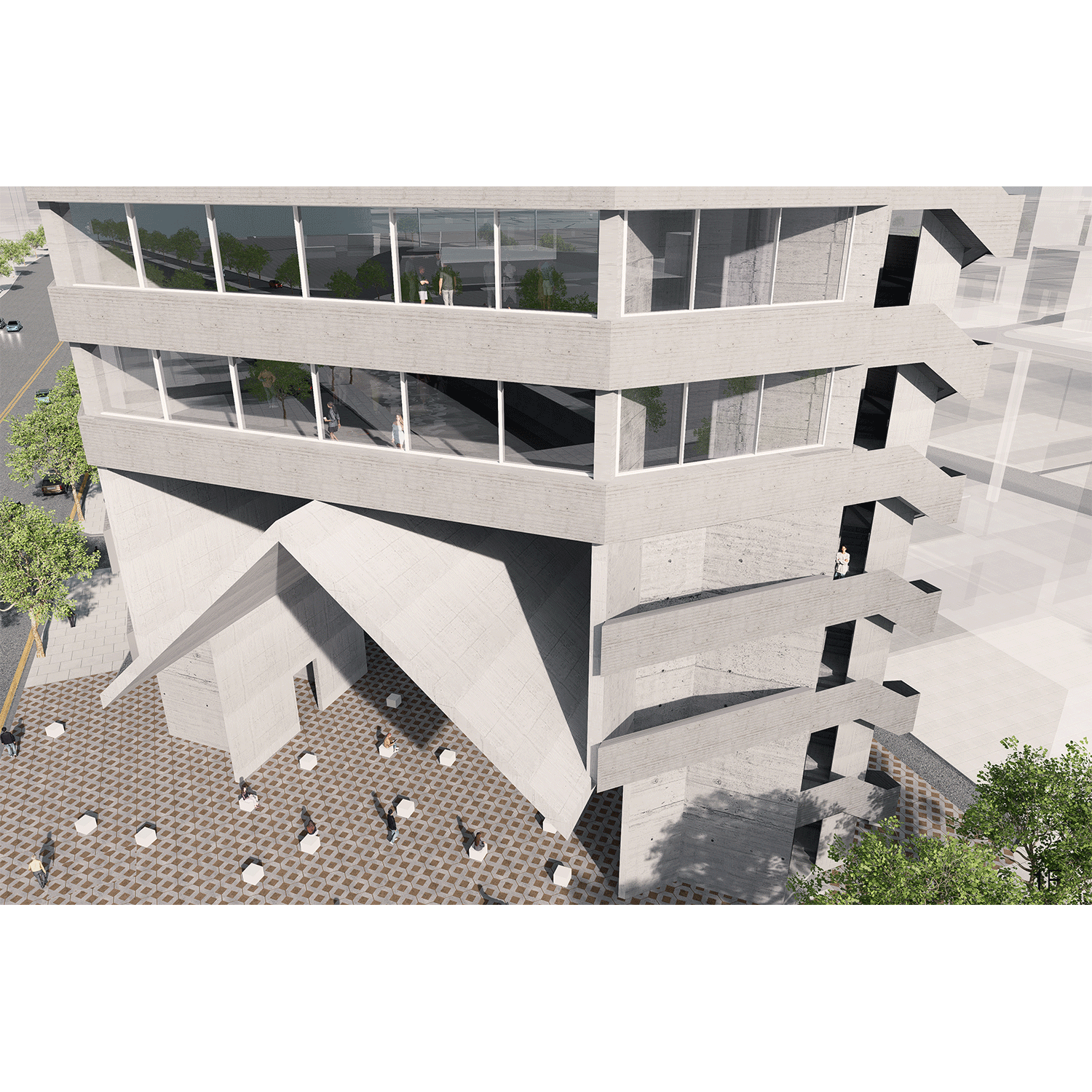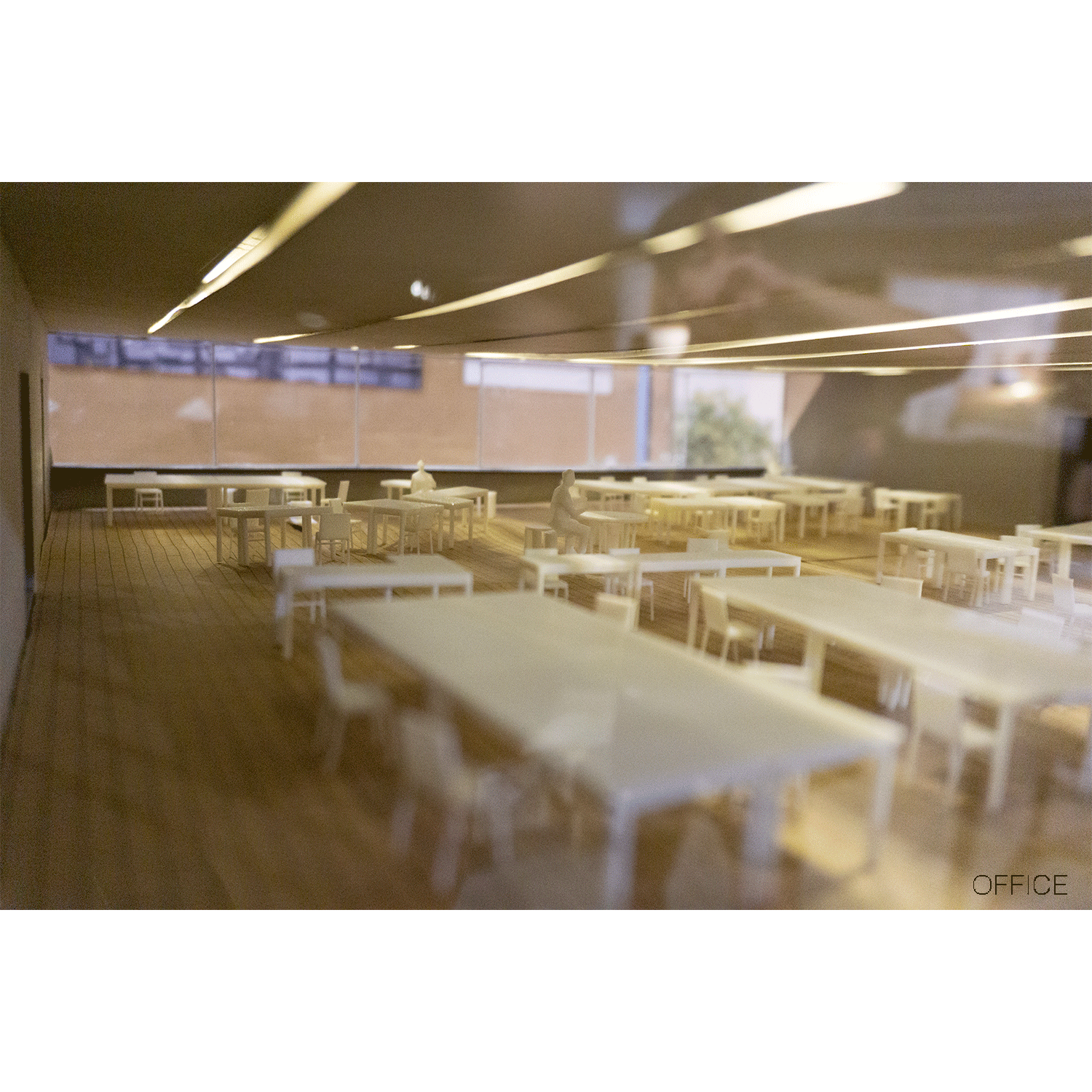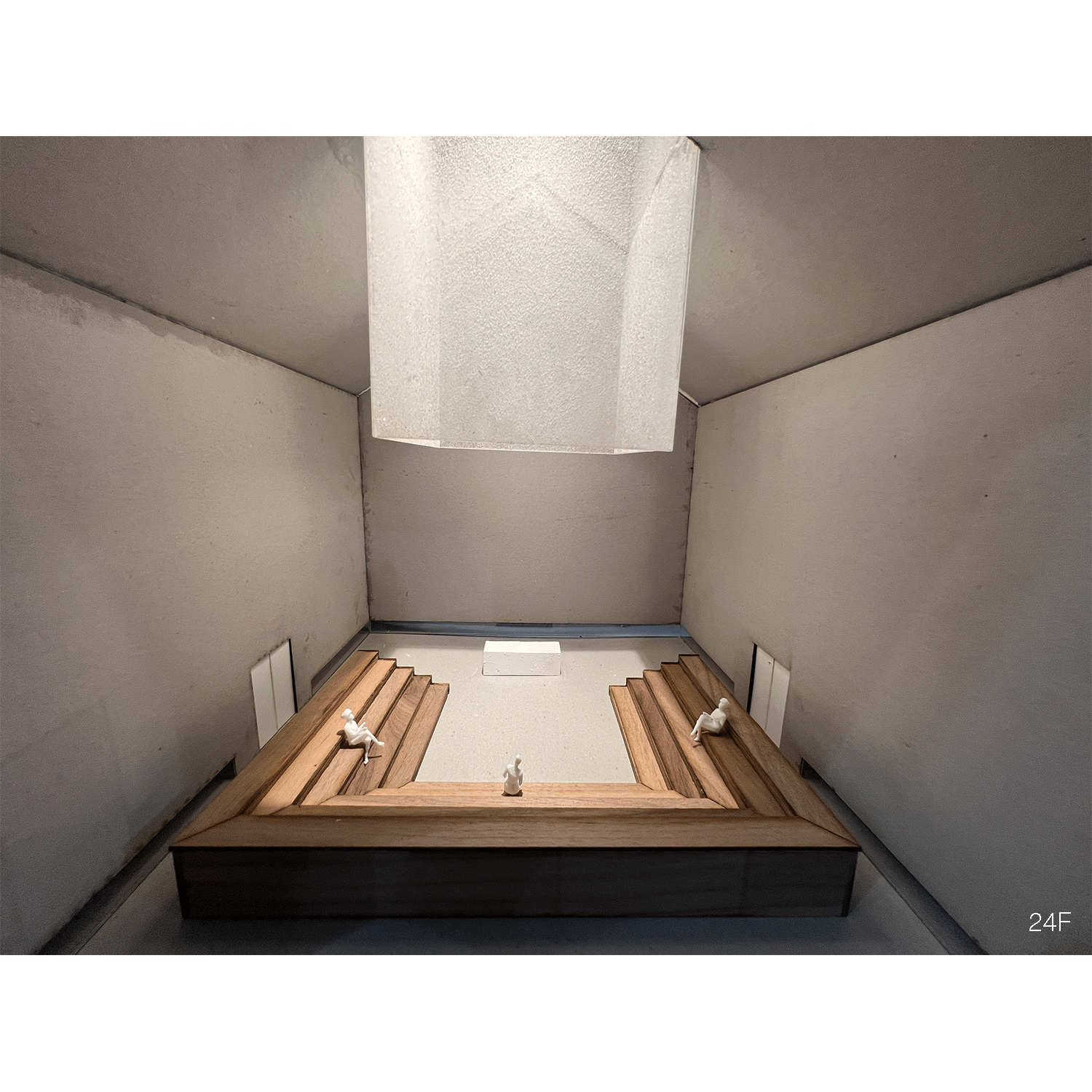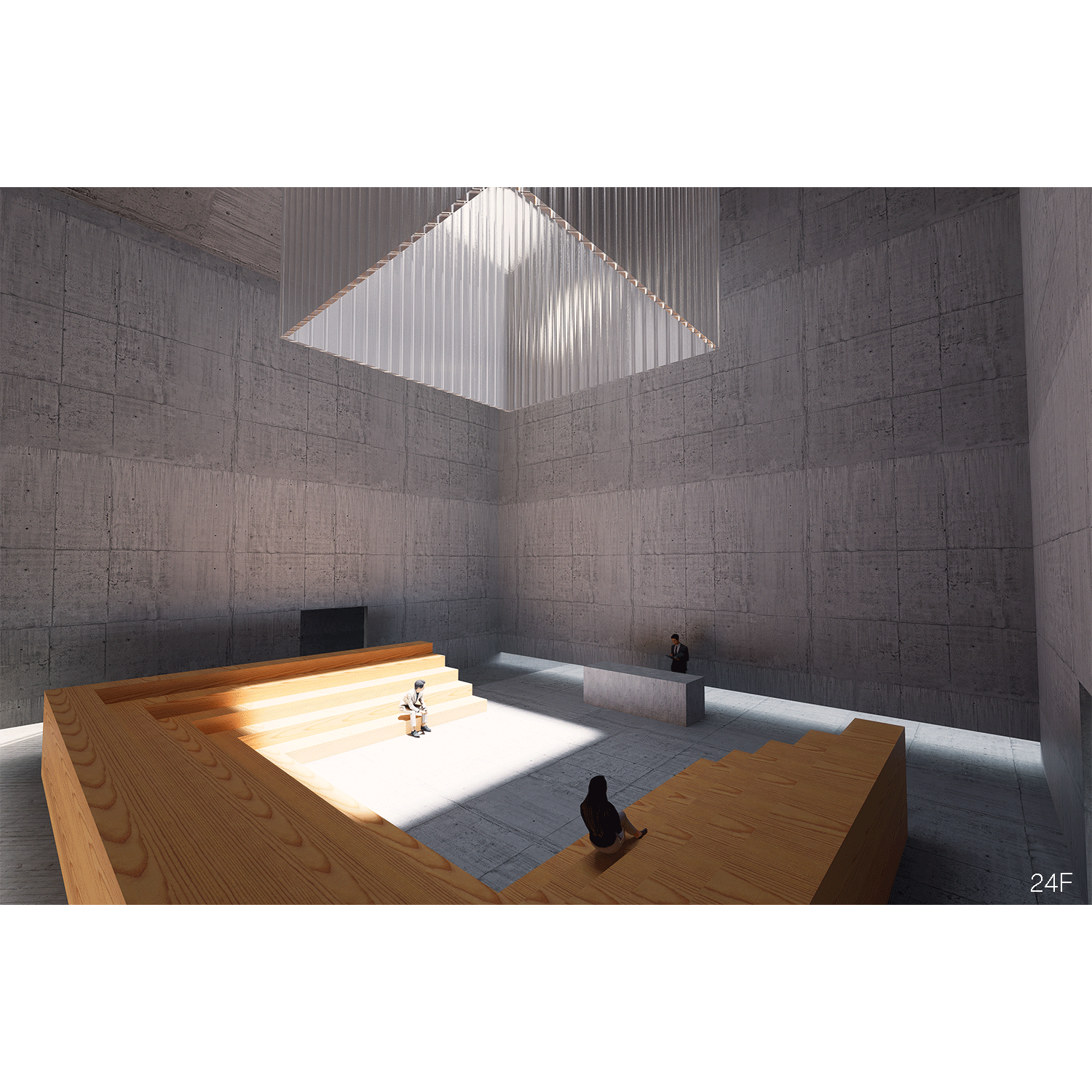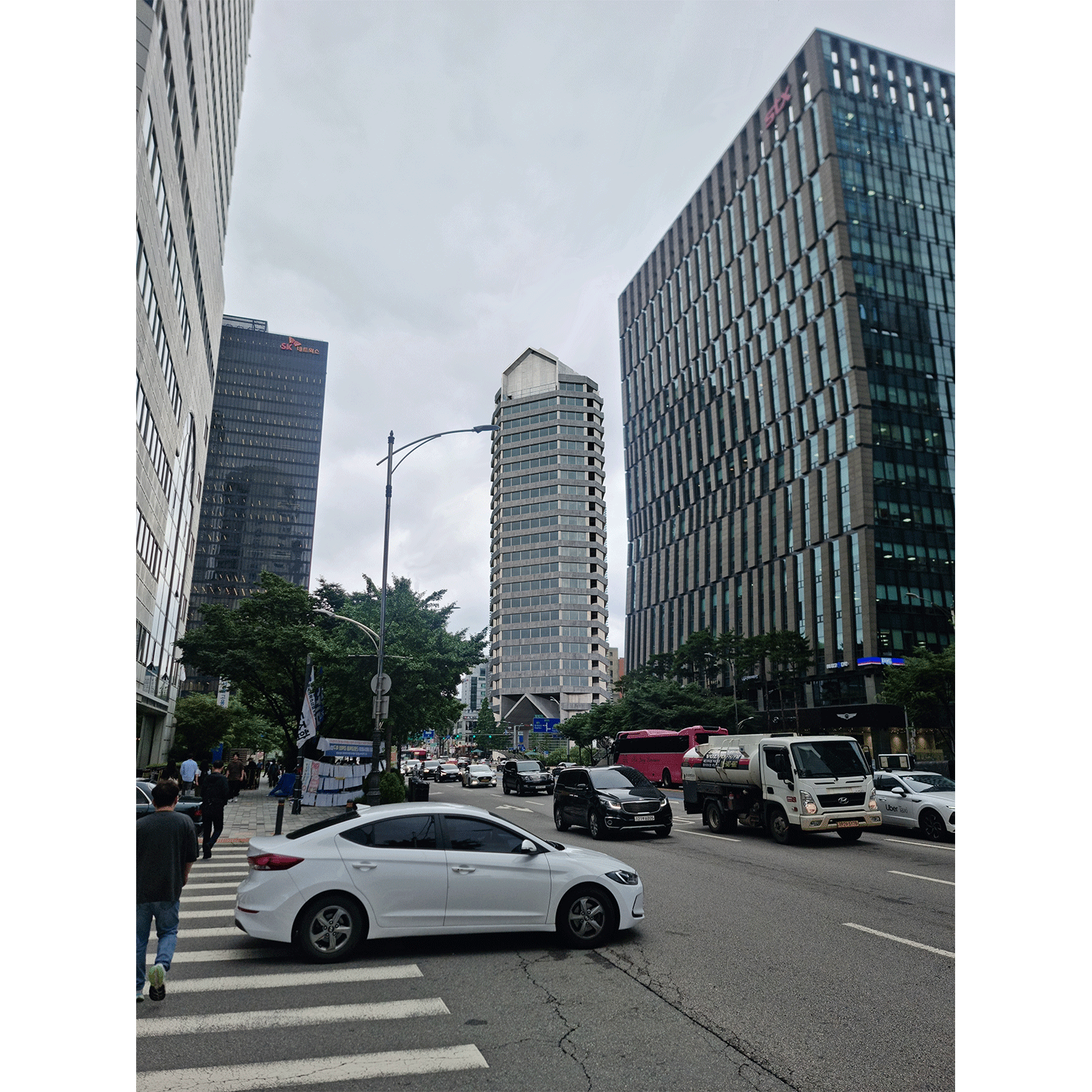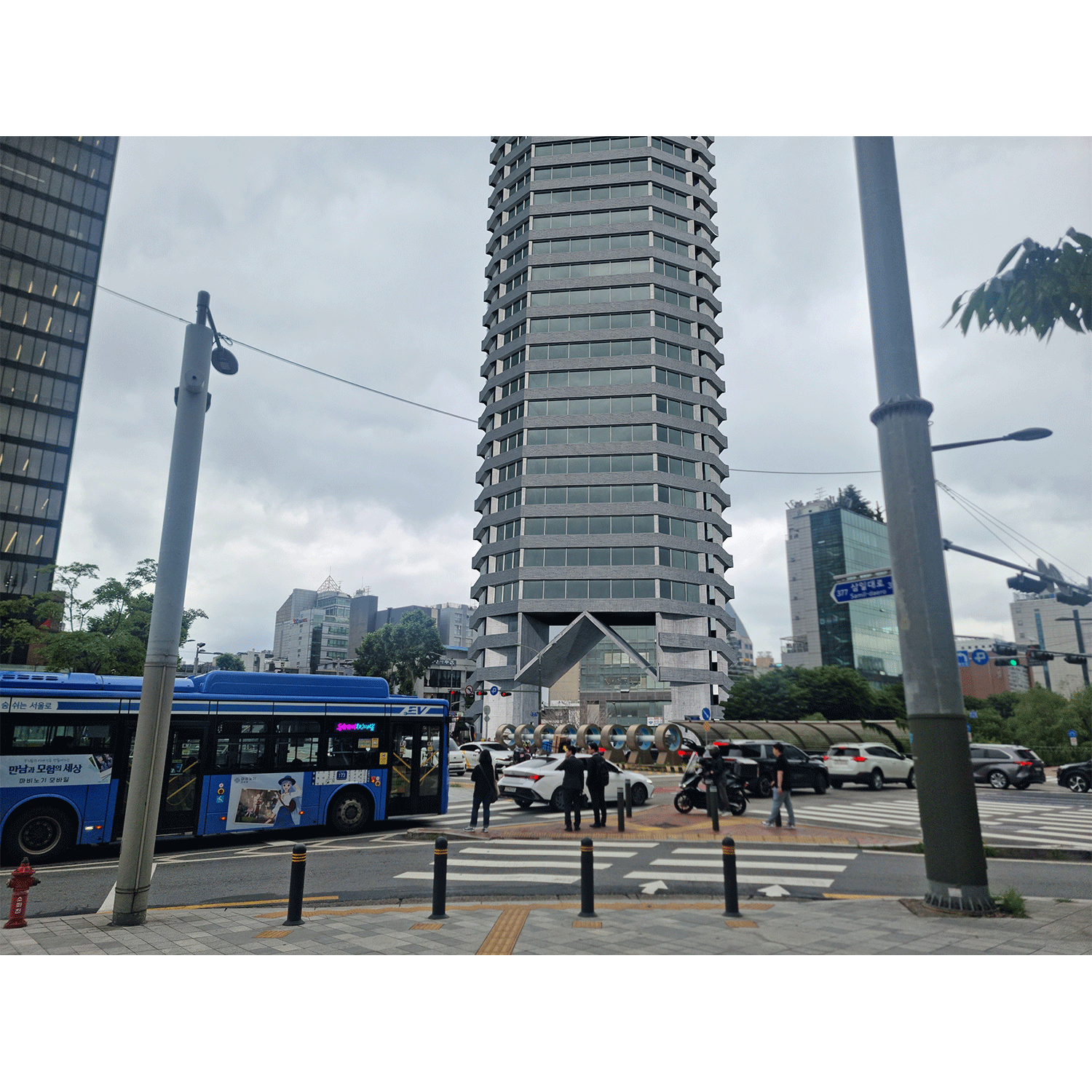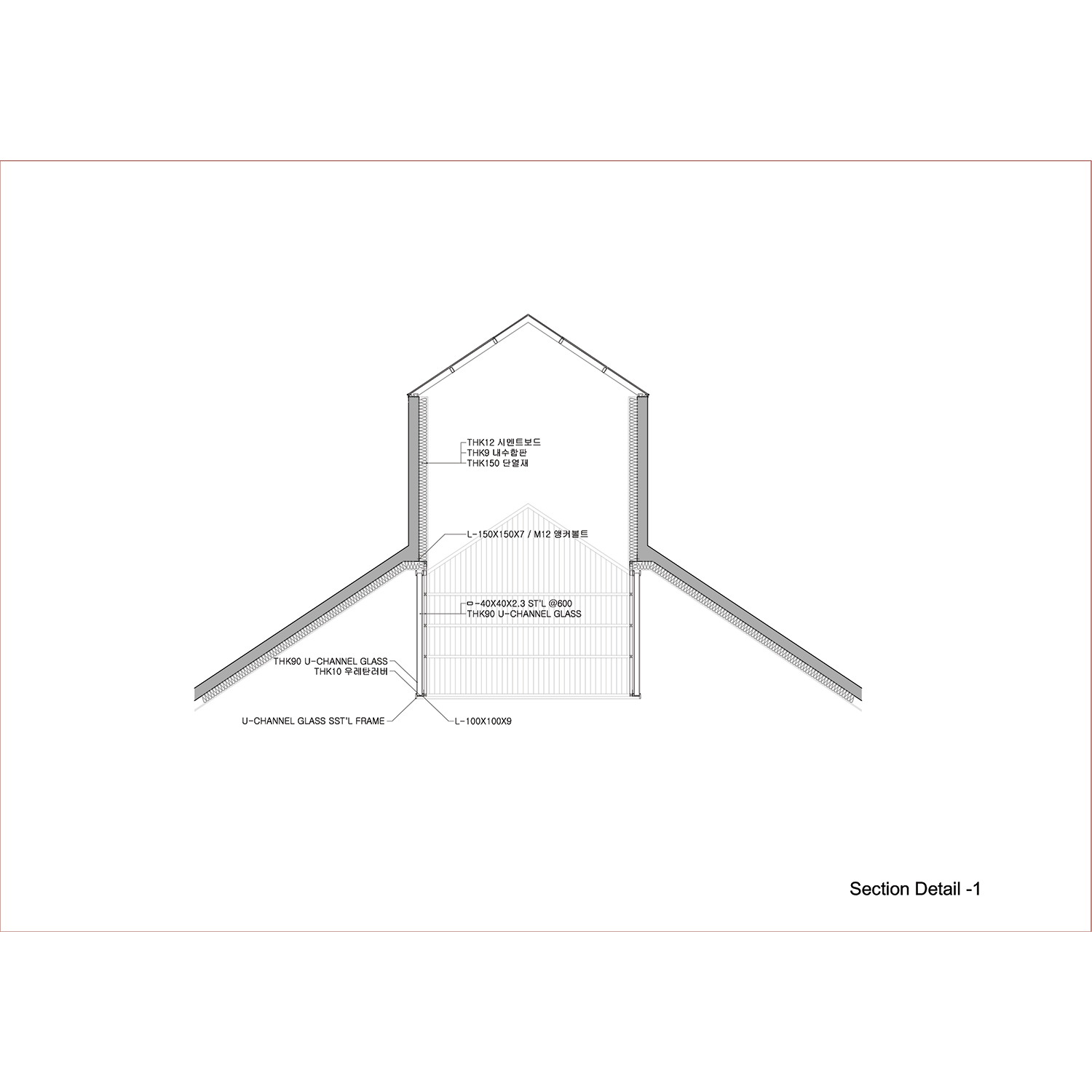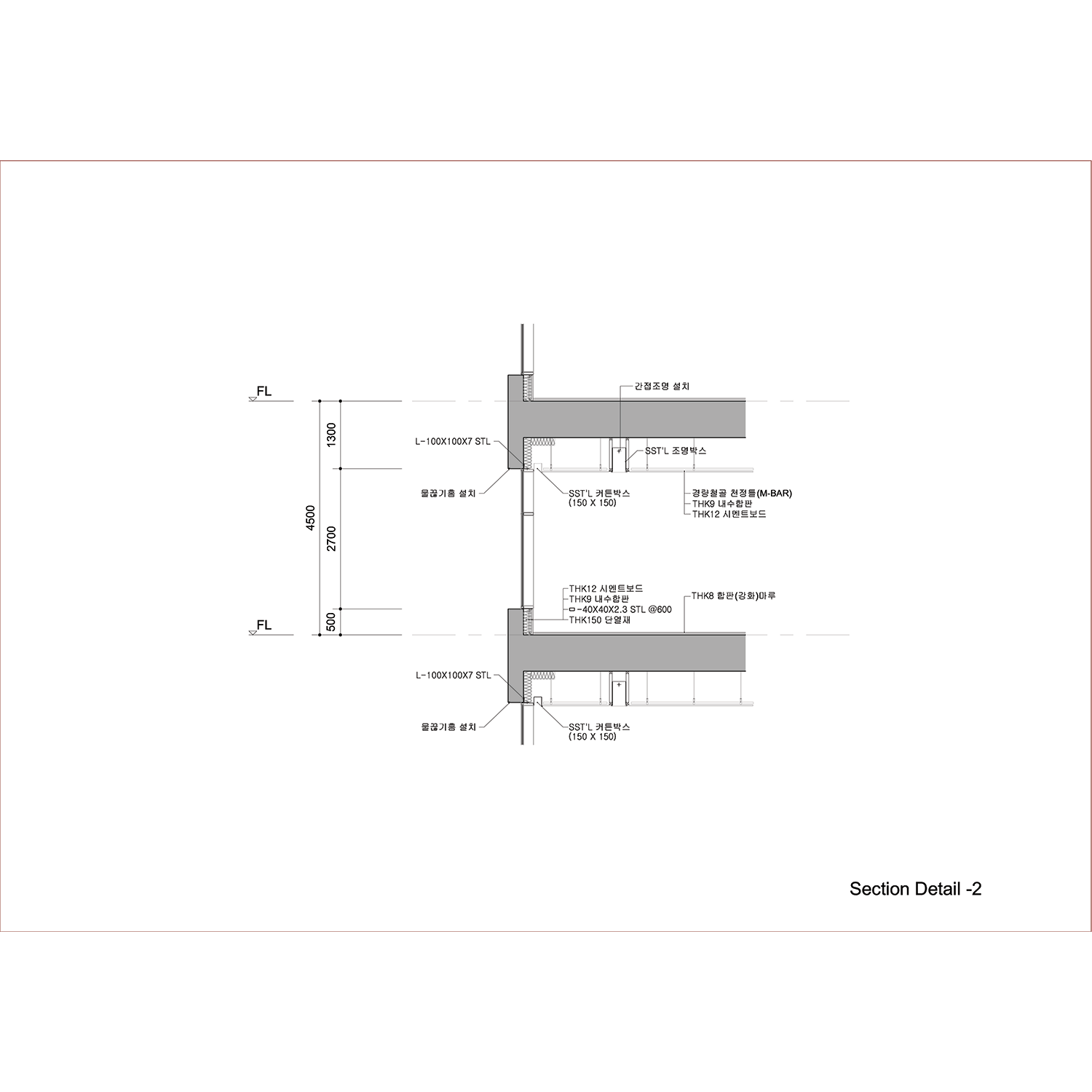지수환 _ 부재의 충만
도심을 걷다 보면, 한두 블록마다 교회 간판이 눈에 띈다. 하지만 성당이나 절이 아닌 '교회'에 들어가 본 경험이 있는가? 성경의 수많은 구절은 교회가 개방돼야 한다고 이야기하지만, 우리는 일상에서 열린 교회를 좀처럼 마주하기 어렵다. 한국의 교회, 특히 개신교의 교회는 예배 시간 외에는 가장 큰 공간인 예배당이 비어 있음에도 불구하고 닫힌 경우가 많다. 과도한 종교 상징, 부정적 이미지, 실질적 운영의 어려움 등은 교회를 모두에게 닫힌 '성(聖)' 혹은 '성(城)'으로 만든다.
열리려는 시도가 없었던 것은 아니다. 도서관, 카페, 주차장 등 많은 것을 내어주었다. 하지만 여전히 교회로 들어가기 위해서는 여러 가지 심리적, 물리적 문을 열어야 한다. 적어도 ‘열린 교회’란 가장 소중한 공간을 내어주는 곳이어야 한다. 그리고 사람들은 여전히 도시 속 고요하고 열려 있는 축(祝)의 공간을 필요로 한다.
교회와 유사하게, 도심 속 오피스 또한 많은 시간 동안 비어 있는 구조다. 특히 1층 로비는 외부와 접하는 거대한 공간이지만, 업무시간 외에는 도시의 흐름을 차단한 채 남아 있다. 그리고 오피스에는 조용한 쉼의 공간이 필요하다.
이 프로젝트의 대상지는 청계천로 93. 오피스가 밀집해 있고 뛰어난 교통 접근성과 더불어 번화가와 관광지의 길목에 위치한 청계천변이다. 주중과 주말을 가리지 않고 다양한 이들이 오가는 이곳은, 도시 속 열린 교회가 자신의 공간을 자연스럽게 드러내고 내어주기에 적합한 장소다.
이처럼 유동 인구가 많은 도심의 접점에, 교회와 오피스라는 두 프로그램이 겹쳐진다. 각자의 시간 속에서 비워지는 이 두 공간은 서로의 공백을 메우며, 그곳에 존재한다. 오피스는 교회를 통해 쉼의 공간, 대공간, 식당 등 다양한 공용공간을 확보하고, 교회는 오피스를 통해 열린 공간 관리를 위한 임대 수익, 그리고 자연스러운 대중의 발걸음을 얻는다. 그렇게 교회는 일상 속으로 스며들고, 대중은 그 안에서 교회의 존재를 부드럽게 인식하게 된다.
교회의 삽입은 '비워냄'의 전략으로 시작된다. 오피스의 일부를 비워냄으로써, 종교적 쉼터가 된다. 1층 로비에는 단순화된 교회 형태가 구현된다. 무거운 소재, 반복되는 패턴, 돋아난 의자, 제단, 천장 높이와 그림자가 과소비된 상징 없이 종교적 분위기를 암시한다. 상징은 최소화되고 장소는 희미한 흔적만이 남는다. 비를 피할 지붕, 딛고 설 바닥은 남기고, 벽을 허문다. 가장 소중한 공간을 내어줌으로써, 교회를 찾아온 이도, 우연히 흘러든 이도 그곳에 있어도 된다고 말해준다. 이곳은 상업시설과 대로를 자연스럽게 이어주며 도시의 일부로 자리 잡는다.
그리고 비워낸 공간은 건물 위로 옮겨진다. 필요한 이들에게 더 내밀한 종교적, 혹은 쉼의 공간을 제공한다. 이곳은 예배당, 대강당, 혹은 고요 속에 나를 들여다보는 공간이 된다. 어느 날에는 회사의 발표회나 파티가 열릴지도 모른다. 누군가는 전망을 보러 올라올 수도 있으며, 잠시 혼자만의 시간을 가지는 이도 있을 것이다. 십자가의 자리에 놓인 것은 더 이상 상징이 아닌 교회 그 자체다. 방문자는 붉은 십자가가 아닌, 교회 그 자체를 보고 이곳을 찾게 된다.
오피스와의 공존으로 서로의 시간에 서로의 용도를 가진다. 이용자들은 고요한 쉼의 공간을 얻고, 교회는 그들과 닿아 있을 수 있다. 회의실은 기도실이 되고 소모임실은 다시 회의실이 된다. 1층의 예배당은 평일엔 오피스의 로비가 되고, 누군가가 공연을 할지도, 지나가는 이가 잠시 햇볕을 피할지도, 혹은 간단한 식사를 할지도 모른다. 담배 한 대에 삶을 태워 뿜어내고, 전날의 스트레스를 모두 게워 내고 텅 빈 몸을 뉠지도 모른다. 그것이 삶의 모습이라면 모든 것을 바라보고 품어낸다.
오피스의 직원들은 업무와 소음을 피해 아래로, 또는 위로 이동한다. 길을 오가던 사람들도 잠시 이곳의 지붕 아래에 앉아 쉴 수 있다. 어떤 이는 눈을 감고 자신이 믿는 무언가에 말을 건넨다. 그리고 언젠가, 그곳이 교회였음을 알게 된다. 그곳은 조용히 곁에 머문다.
비움으로 충만해지는, 부재의 충만.
In South Korea, church signs appear every few blocks throughout the city. Yet how many people have actually stepped into a Protestant church—not a temple, nor a Catholic cathedral?
Although the Bible speaks repeatedly of the church as a space that must remain open, such openness is rarely encountered in Korean daily life.Particularly in South Korea, Protestant churches often remain closed outside of worship hours, even when their largest spaces—the sanctuaries—are left empty.Excessive religious symbolism, negative public perception, and practical management challenges have rendered churches closed off to all—a sacred place (聖), but also a fortress (城).
Attempts to open up have not been absent. Churches have offered libraries, cafés, and parking lots. Yet entering one still requires passing through multiple psychological and physical thresholds. At the very least, an Open Church must be one that gives up its most sacred space. And still, people long for places of stillness—open, silent spaces where prayer may quietly dwell—within the city.
Similarly, office buildings in the city remain empty for long stretches of time. The first-floor lobbies, which face the street and span generous volumes, are often closed off after business hours, cutting off the flow of the city. Offices, too, are in need of quiet spaces for rest.
This project is located at 93 Cheonggyecheon-ro, along a stream corridor dense with office towers. The site boasts excellent transit access and sits at the edge of bustling commercial and tourist districts. People pass through here day and night, weekday or weekend.
It is a place where an Open Church can quietly reveal itself, offering its space to many.
At this intersection of urban flows, the programs of church and office come together. Each becomes vacant at different times, and in doing so, they fill each other’s voids. The office gains shared spaces—rest areas, large halls, and a cafeteria—through the church. The church, in turn, secures rental income and naturally attracts public footfall through the office. In this way, the Open Church seeps into daily life, and the public comes to recognize its presence not through symbolism, but through experience.
The insertion of the church begins with a strategy of subtraction. By carving out a portion of the office, the building becomes a spiritual refuge. On the ground floor, a simplified church form takes shape. Heavy materials, repetitive patterns, raised seating, an altar, ceiling height, and shadows suggest a sacred atmosphere—without excessive religious symbols. Symbolism is minimized; only subtle traces remain.
A roof to block the rain, a floor to stand on—the walls are removed. By offering its most valued space, the church welcomes both those who came seeking it and those who simply wandered in. This place connects naturally with commercial facilities and public streets, becoming part of the city itself.
The space that has been subtracted is also lifted upward. There, a quieter and more intimate space is offered—to those in need of spiritual pause or simple retreat. This rooftop may serve as a sanctuary, an assembly hall, or a place for introspection. On some days, it may host a company presentation or party. Others might come for the view—or to be alone. What now occupies the place where a cross might stand is no longer a symbol, but the church itself. Visitors do not come for a red neon cross. They come because the space itself is the Open Church.
Through coexistence with the office, each program adopts the other’s time and purpose. Office users gain peaceful places to rest; the church gains proximity to daily life. A meeting room becomes a prayer room, a small group room becomes a meeting room again. The first-floor sanctuary becomes the office lobby during weekdays. Someone might perform there. Someone else might sit for a moment in the shade, or have a simple meal. A cigarette may burn away the weight of yesterday. Someone might empty out their stress, lie down in silence. If that, too, is part of life—then this space watches quietly, and embraces it all.
Office workers move upward or downward to escape the noise. Passersby pause and sit beneath its roof. Some close their eyes and speak to something they believe in. And someday, they may come to realize: they were in a church. It remained quietly, beside them.
Fullness through Absence, Fullness of Absence.
